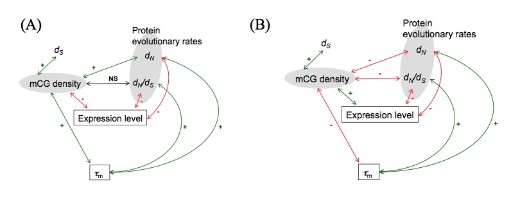DNA methylation is already a known key factor that attributes to the gene expression, namely, its presence has a direct correlation between regarding gene being “turned on” or not, therefore, it has become quite a marker for epigenetic study.
Studies have shown, methylation is a process to genes as important as the gene sequence itself. As a matter of fact, methylation could be the major reason that have caused a should be functioning gene non-functioning, it could also trigger a gene to over react and causes tumor cell growth.
In view of molecular evolution, DNA methylation is generally mutagenic and may increase the level of sequence divergence. Meanwhile, DNA methylation of gene bodies was reported to be linked to increased gene expression level. A controversy on whether DNA methylation may increase or decrease protein evolutionary rate thus results, for highly expressed genes are known to evolve slowly.
In order to answer whether methylation is associated with increased or decreased mutation rates, Dr. Trees-Juen Chuang decided to use the knowledge of Bioinformatics to drill into the problem.
The team used experimentally determined DNA methylation data to analyze the correlation between DNA methylation levels and evolutionary rates in coding exons. They studied from six human cell lines spanning multiple spatial (i.e., blood cells, embryonic stem cells (ESCs), and different fibroblasts) and temporal dimensions (i.e., undifferentiated human ESCs, ESC-derived fibroblasts, and neonatal fibroblasts).
Their study showed, the first exons are more prone to the increase in mutation rate, whereas the internal and last exons seem to be more affected by the regulatory effects of DNA methylation.
In short, it matters greatly at which position a coding exon exist when methylation takes place. DNA methylation level is more strongly correlated with CpG dinucleotide mutations in the first coding exons than in the internal and last exons, although it is positively correlated with synonymous substitution rate regardless of exon positions. In addition, for the first exons, highly methylated regions tend to have lower levels of expression, higher levels of sample specificity of DNA methylation level, and higher nonsynonymous substitution rates, whereas the reverse are true for the internal and last exons (Fig. 1). The study has answered the previous dispute and might provide some clues to methylation-related human diseases.
This research team is led jointed by Dr. Trees-Juen Chuang and Dr. Feng-Chi Chen (National Health Research Institutes). The software engineer is Mr. Yen-Zho Chen. A research paper has been published on the August 2012 PNAS journal. This research has also been reported by A-IMBN Research in December 2012.
According to Dr. Chuang, Bioinformatics is a research territory that combines the knowledge of biology, creativities of the scientists, and the disciplines of Information technology engineers. Together, they can bring projections and calculations to resolve biological problems in a way no lab works can singly achieve with speed and accuracy. Those who would like to challenge the problems of life in an innovative way are welcome to join their team.
